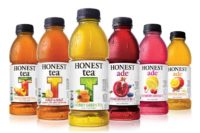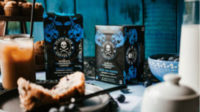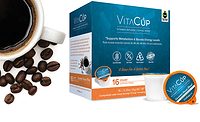Consumers enjoy their cup of tea
Premium, organic positioning heat up tea category

Nestlé Waters North America announced an agreement to purchase Sweet Leaf Tea Co., which includes Sweet Leaf Tea and Tradewinds Tea brands.

Bigelow Tea Co., Fairfield, Ct., released products that combine tea with the health benefits of antioxidant-rich fruits.

Crystal Geyser Water Co. released California Teas, an all-natural ready-to-drink line in select markets.



Consumers are refining their tastes when it comes to tea. Product launches and sales data suggest that organic positioning for teas and ready-to-drink (RTD) teas are helping to sustain and grow certain aspects of the category. According to Innova Market Insights, Duiven, The Netherlands, 20.9 percent of the 1,966 new products launched in the United States in 2010 for bagged and loose leaf tea carried an organic claim. That percentage was even higher for 157 RTD teas launched last year with 43.3 percent labeled as organic.
Richard Haffner, head of global beverage research with Euromonitor International, Chicago, sees that organic and natural labeling of teas will continue to be a prominent part for the category.
“I think [organic and natural] will play an increasing role,” he says “and it plays into the health benefits and the premium quality perception where I think the category is moving.”
Large companies also saw the increasing demand for organic and natural with The Coca-Cola Co., Atlanta, purchasing Honest Tea, Bethesda, Md., earlier this year, and Nestlé Waters North America, Stamford, Conn., announcing the purchase of Sweet Leaf Tea Co., Austin, Texas, which includes Sweet Leaf Tea and Tradewinds Tea brands.
Sweet Leaf Tea Co. has positioned its brands to address the demand for organic and natural teas.
“Consumers and buyers are really interested in organic products and all-natural products that taste great,” says Charla Adams, Sweet Leaf Tea Co. brand marketing manager. “Both of our brands, Sweet Leaf Tea and Tradewinds, are unique in the quality that we offer as well as the taste.”
Adams notes that Sweet Leaf Tea began its products organic and all-natural and that the positioning is a core part of the brands and products. The Sweet Leaf Tea brand also uses pure cane sugar as its sweetener, which Adams says is “an essential part of the recipe.”
And with the company’s recent acquisition by Nestlé Waters, Sweet Leaf Tea Co. is optimistic about its ability to expand the organic and all-natural reach of the category.
“Both of our brands are still very small and with the support of Nestlé Waters North America we hope to dramatically increase our distribution so that fans of Sweet Leaf and Tradewinds Tea can find a bottle wherever they shop,” Adams says.
Sweet Leaf saw a large increase with a 56.3 percent increase in sales for $10 million in sales and Tradewinds Tea experienced a 14.6 percent increase for more than $8.5 million in sales, for the 52 weeks ending April 17 in supermarkets, drug stores and mass merchandise stores, excluding Wal-Mart, states SymphonyIRI Group, Chicago.
According to SymphonyIRI, Honest Tea’s RTD sales increased 56 percent for $16.9 million in sales.
“I think Coke is looking to participate in [organic tea],” Haffner says. “It’s a lot easier where they have a brand that was establishing themselves in that area as Honest Tea [has]. Sweet Leaf with Nestlé is a natural extension, and I see the ready-to-drink category moving a bit in that direction.”
Natural also was a popular health positioning for teas launched last year making up 7.7 percent and 21 percent for RTD tea, according to Innova data.
In the natural segment of the tea category companies also invested in launching new lines. Lipton Iced Tea, a product of the Pepsi Lipton Tea Partnership, launched a line of beverages that contain all-natural ingredients. The 100 Percent Natural Lipton Iced Tea line was created in response to consumers’ continued desire for health, wellness and natural products, the company says. The beverages are made with Lipton tea, real sugar and natural flavors, it says.
Crystal Geyser Water Co., Calistoga, Calif., also released an all-natural line in select markets with California Teas.
“For over 30 years, Crystal Geyser has been committed to creating premium quality, wholesome and delicious natural beverages,” the company says. “The all-natural California Teas continue Crystal Geyser’s heritage of providing premium natural beverages that are good for consumers.”
Part of that natural positioning is using pure cane sugar to sweeten its teas, Crystal Geyser says. The company says it learned from consumer feedback that perception was that bottled teas in the market were too sweet, contained artificial sweeteners and did not taste natural.
“We decided to lightly sweeten California Teas with pure cane sugar to address these consumer concerns and it resulted in a superior flavor without being overly sweet,” the company says.
Healthier positioning
The RTD tea segment experienced notable growth as its sales increased 9.2 percent equating to more than $1.3 billion, as of April 17, according to SymphonyIRI data. The top seller Arizona Teas increased 3.5 percent for more than $333.8 million in sales. However, other brands in the Top 10 saw mixed results as Lipton, Lipton Diet and Lipton Pureleaf experienced decreases, although Lipton Brisk showed a 12 percent increase for $94 million in sales. Other brands that performed well in the Top 10 were Arizona’s Arnold Palmer Tea posting a 100.3 percent increase and The Coca-Cola Co.’s Gold Peak brand with a 175.6 percent increase in sales, SymphonyIRI data states.
Haffner says that Gold Peak has benefited from its bulk packaging, such as the 59-ounce carafes.
“What that does is it opens up Gold Peak to more of a home audience in bulk serving at dinner and that kind of occasion,” he says.
But when it comes to what has helped fuel the success that RTD teas have experienced in the past year, Haffner says, that can be linked to its convenience and perceived health benefits.
“It’s a lot more convenient because it doesn’t have to be brewed so it’s easier to get,” he says. “Then the health benefits translated well to these products because [when] you think about ready-to-drink there’s a lot of unhealthy options there, and so the ready-to-drink teas are providing a healthier option and that’s one.”
In addition to organic and natural health positions, other top claims for RTD teas include antioxidants at 24.8 percent as well as energy and alertness, according to Innova.
Another segment for the RTD tea market, low calorie, was used by 22.3 percent of last year’s product launches, Innova data states.
Ito En North America Inc., Brooklyn, N.Y., relaunched its Teas’ Tea line with a three-tier approach, adding a Lightly Sweetened tier. Its Lightly Sweetened products feature new low-calorie flavors that contain between 8 to 9 grams of natural cane sugar and 40 calories in each serving.
Haffner adds that RTD teas have seen an increased in on-premise presence.
Brewing sales
Bagged and loose leaf tea also had a positive year posting a 1.8 percent increase for just shy of $777.6 million in sales, according to SymphonyIRI. The category benefited from brands such as Bigelow Tea, which had a 4 percent sales increase for $89 million. Twinings of London and Celestial Seasonings also showed an increase at 6 percent and 7.6, respectively. Tazo Tea, a brand of Seattle-based Starbucks, was the only brand in the Top 10 that showed double digit growth at 14.3 percent, according to the market research firm.
Haffner says bagged and loose leaf teas experienced moderate growth due to the market’s saturation of black standard teas, which are not considered premium teas, and he says consumers are gravitating to premium tea.
“I see those more premium-type teas driving the growth,” Haffner says. “The ones that have the more health benefits associated with them and that will come at the expense of black standard teas that are the less expensive teas.”
Last year Talbott Teas, Chicago, partnered with the Trump Organization to launch Trump Tea, a premium line of teas inspired by the luxury and sophistication associated with the Trump brand, the companies say. Blend varieties feature names such as Park Avenue, Union Square, Mar-A-Lago and Westchester.
Innova data states that top health positions for teas in 2010 include antioxidant at 14.7 percent, digestive and gut health at 5.8 percent as well as heart health at 4.8 percent.
Earlier this year, Bigelow Tea Co., Fairfield, Ct., released Black Tea with Pomegranate, Decaffeinated Green Tea with Pomegranate, and Decaffeinated Green Tea with Wild Blueberry and Acai. The products combine tea with the health benefits of the antioxidant containing fruits.
Haffner sees the promotion of health positions will continue for the tea category.
“I think in the future you’ll see some more specifics around the benefits instead of talking antioxidants and catechins, you might start talking about heart health, immunity, things like that where they’ll get more specific in the future,” he says.
Red and white teas for the past few years have performed well, Haffner says, and he associates that with their increased distribution, but also because of the health benefits associated with them. Although he foresees those varieties to continue to grow, it won’t be as rapid as it has been in the past four to five years, Haffner adds.
A growing market in the tea bag segment exists for brewed teas that can be chilled, Haffner says.
“There’s hot tea bags specifically formulated to make iced tea so I think that plays into Americans taste for iced tea,” he says. “It’s not popular in a lot of the world, but it’s very big here and being able to brew it and make it iced is a nice premium product to be served at home.”
Haffner also thinks that pyramid tea bags will be a growing part of the tea category.
“I think those will be a big innovation because the types of teas that go in there can be more premium and they’re also more whole leaf tea that goes in there and so that type of bag is associated with a more premium product, and I think that that’s going to be a big innovation going forward,” he says.
And with increasing demand for the pod machines for coffee, Haffner says that tea could become a niche in that market as the machines increase penetration.
Looking for a reprint of this article?
From high-res PDFs to custom plaques, order your copy today!











